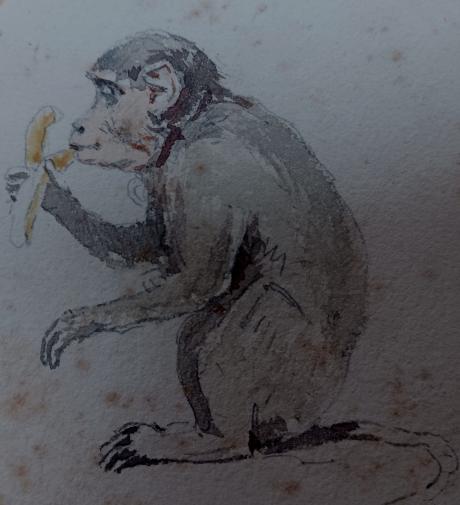Aside from humans the macaques are the most widespread primate genus, ranging from Japan to the Indian subcontinent, and in the case of the Barbary macaque (Macaca sylvanus), to North Africa and Southern Europe. Twenty-three macaque species are currently recognized. Macaques are robust primates whose arms and legs are about the same in length. The fur of these animals is typically varying shades of brown or black and their muzzles are rounded in profile with nostrils on the upper surface. The tail varies among each species, which can be long, moderate, short or totally absent. Although several species lack tails, and their common names refer to them as apes, these are true monkeys, with no greater relationship to the true apes than any other Old World monkeys. Instead, this comes from an earlier definition of 'ape' that included primates generally.
In some species, skin folds join the second through fifth toes, almost reaching the first metatarsal joint. The monkey's size differs depending on sex and species. Males from all species can range from 41 to 70 cm (16 to 27.5 in) in head and body length, and in weight from 5.5 to 18 kg (12 to 40 lb). Females can range from a weight of 2.4 to 13 kg (5.3 to 28.7 lb). These primates live in troops that vary in size, where males dominate, however the order of dominance frequently shifts. Female dominance lasts longer and depends upon their genealogical position. Macaques are able to swim and spend most of their time on the ground and spend some time in trees. They have large pouches in their cheeks where they carry extra food. They are considered highly intelligent and are often used in the medical field for experimentation due to their remarkable similarity to humans in emotional and cognitive development. Extensive experimentation has led to the long-tailed macaque being listed as endangered.
Lionel Grimston Fawkes, grandson of Walter Ramsden Hawkesworth Fawkes (an MP and patron of Turner), began his military training at the Royal Military Academy, Woolwich, he became professor of military topography there... By 1883 he was Dominic Gamble’s aide-de-camp in Jamaica. In 1885 he entered Staff College, Sandhurst. He became a Colonel in the Royal Artillery and later a Justice of the Peace. In 1891 he married Lady Constance Eleanor Kennedy, daughter of a Scottish peer. He was Professor of Military Topography at the Royal Military Academy from 1895 to 1900. By 1923 he and his wife had moved to Canada, purchasing the Point Comfort Hotel on Mayne Island and changing its name to Culzean after Constance’s ancestral home, Culzean Castle. They remained at Culzean for the rest of their lives.
Colonel Fawkes was a very accomplished artist and illustrator. His water-colours are held in collections around the world. Their married daughter, Lois died in 1919 leaving a one year old son Lawrence. Tragedy struck the Fawkes family again in 1921, when their other daughter, Monica, also died. This was all too much for the Colonel and Lady Constance and in 1924 they emigrated to Mayne Island, British Columbia with their son-in-law and grandson

